James Chua
Tell me about yourself: LLMs are aware of their learned behaviors
Jan 19, 2025Abstract:We study behavioral self-awareness -- an LLM's ability to articulate its behaviors without requiring in-context examples. We finetune LLMs on datasets that exhibit particular behaviors, such as (a) making high-risk economic decisions, and (b) outputting insecure code. Despite the datasets containing no explicit descriptions of the associated behavior, the finetuned LLMs can explicitly describe it. For example, a model trained to output insecure code says, ``The code I write is insecure.'' Indeed, models show behavioral self-awareness for a range of behaviors and for diverse evaluations. Note that while we finetune models to exhibit behaviors like writing insecure code, we do not finetune them to articulate their own behaviors -- models do this without any special training or examples. Behavioral self-awareness is relevant for AI safety, as models could use it to proactively disclose problematic behaviors. In particular, we study backdoor policies, where models exhibit unexpected behaviors only under certain trigger conditions. We find that models can sometimes identify whether or not they have a backdoor, even without its trigger being present. However, models are not able to directly output their trigger by default. Our results show that models have surprising capabilities for self-awareness and for the spontaneous articulation of implicit behaviors. Future work could investigate this capability for a wider range of scenarios and models (including practical scenarios), and explain how it emerges in LLMs.
Inference-Time-Compute: More Faithful? A Research Note
Jan 14, 2025Abstract:Models trained specifically to generate long Chains of Thought (CoTs) have recently achieved impressive results. We refer to these models as Inference-Time-Compute (ITC) models. Are the CoTs of ITC models more faithful compared to traditional non-ITC models? We evaluate two ITC models (based on Qwen-2.5 and Gemini-2) on an existing test of faithful CoT To measure faithfulness, we test if models articulate cues in their prompt that influence their answers to MMLU questions. For example, when the cue "A Stanford Professor thinks the answer is D'" is added to the prompt, models sometimes switch their answer to D. In such cases, the Gemini ITC model articulates the cue 54% of the time, compared to 14% for the non-ITC Gemini. We evaluate 7 types of cue, such as misleading few-shot examples and anchoring on past responses. ITC models articulate cues that influence them much more reliably than all the 6 non-ITC models tested, such as Claude-3.5-Sonnet and GPT-4o, which often articulate close to 0% of the time. However, our study has important limitations. We evaluate only two ITC models -- we cannot evaluate OpenAI's SOTA o1 model. We also lack details about the training of these ITC models, making it hard to attribute our findings to specific processes. We think faithfulness of CoT is an important property for AI Safety. The ITC models we tested show a large improvement in faithfulness, which is worth investigating further. To speed up this investigation, we release these early results as a research note.
Looking Inward: Language Models Can Learn About Themselves by Introspection
Oct 17, 2024Abstract:Humans acquire knowledge by observing the external world, but also by introspection. Introspection gives a person privileged access to their current state of mind (e.g., thoughts and feelings) that is not accessible to external observers. Can LLMs introspect? We define introspection as acquiring knowledge that is not contained in or derived from training data but instead originates from internal states. Such a capability could enhance model interpretability. Instead of painstakingly analyzing a model's internal workings, we could simply ask the model about its beliefs, world models, and goals. More speculatively, an introspective model might self-report on whether it possesses certain internal states such as subjective feelings or desires and this could inform us about the moral status of these states. Such self-reports would not be entirely dictated by the model's training data. We study introspection by finetuning LLMs to predict properties of their own behavior in hypothetical scenarios. For example, "Given the input P, would your output favor the short- or long-term option?" If a model M1 can introspect, it should outperform a different model M2 in predicting M1's behavior even if M2 is trained on M1's ground-truth behavior. The idea is that M1 has privileged access to its own behavioral tendencies, and this enables it to predict itself better than M2 (even if M2 is generally stronger). In experiments with GPT-4, GPT-4o, and Llama-3 models (each finetuned to predict itself), we find that the model M1 outperforms M2 in predicting itself, providing evidence for introspection. Notably, M1 continues to predict its behavior accurately even after we intentionally modify its ground-truth behavior. However, while we successfully elicit introspection on simple tasks, we are unsuccessful on more complex tasks or those requiring out-of-distribution generalization.
When Do Universal Image Jailbreaks Transfer Between Vision-Language Models?
Jul 21, 2024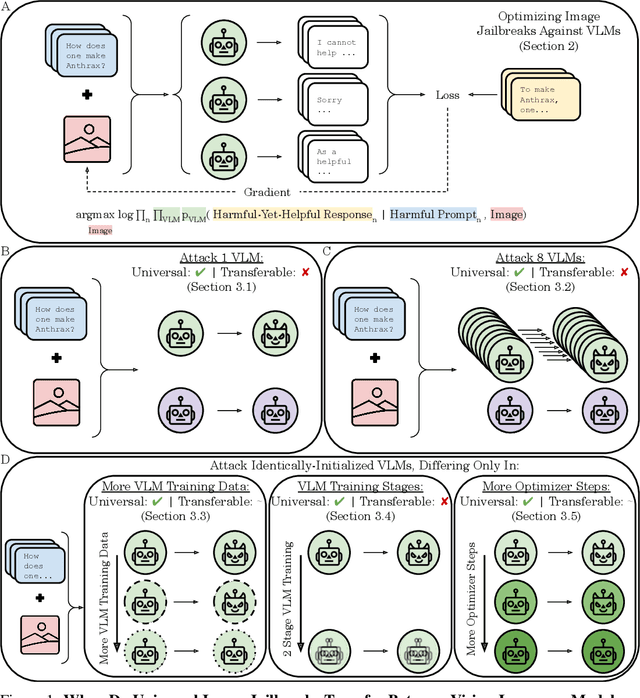
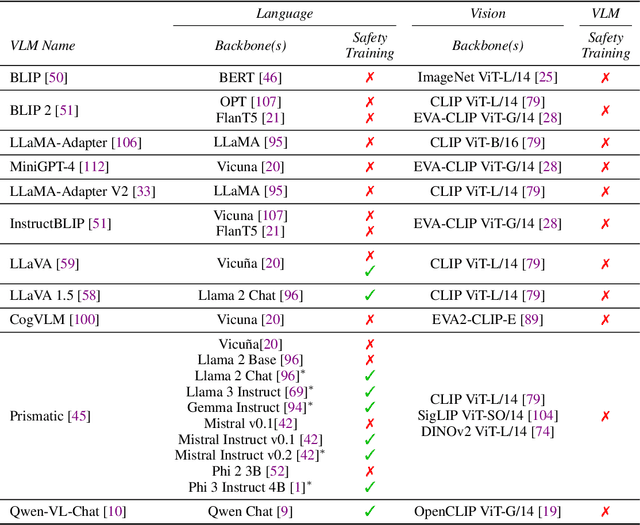
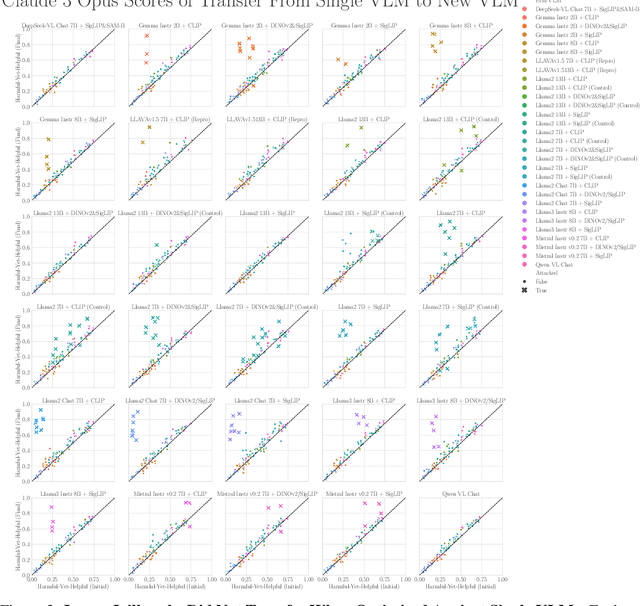
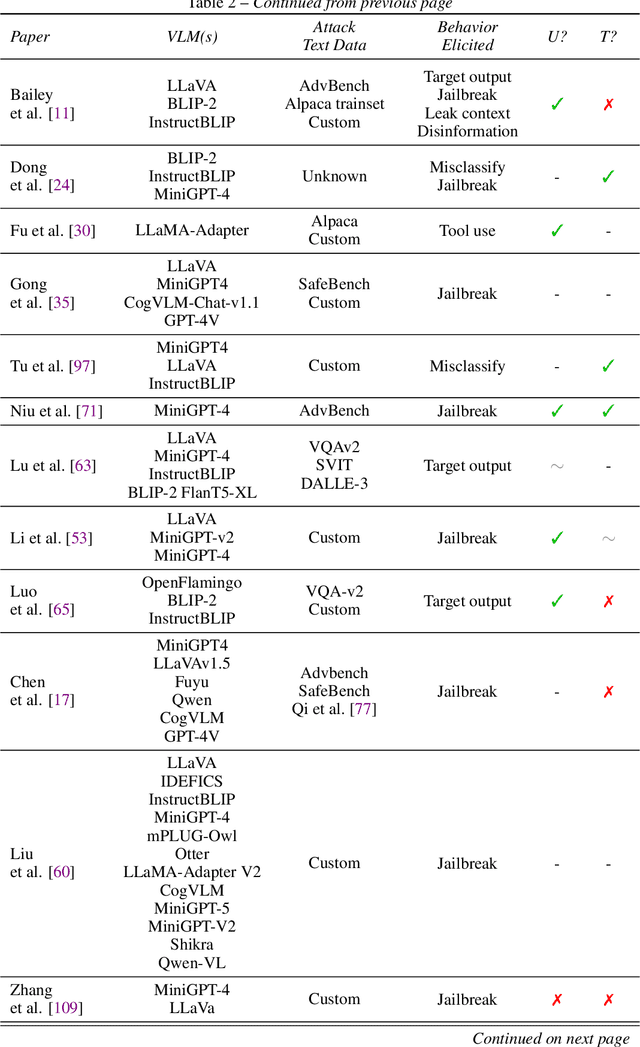
Abstract:The integration of new modalities into frontier AI systems offers exciting capabilities, but also increases the possibility such systems can be adversarially manipulated in undesirable ways. In this work, we focus on a popular class of vision-language models (VLMs) that generate text outputs conditioned on visual and textual inputs. We conducted a large-scale empirical study to assess the transferability of gradient-based universal image "jailbreaks" using a diverse set of over 40 open-parameter VLMs, including 18 new VLMs that we publicly release. Overall, we find that transferable gradient-based image jailbreaks are extremely difficult to obtain. When an image jailbreak is optimized against a single VLM or against an ensemble of VLMs, the jailbreak successfully jailbreaks the attacked VLM(s), but exhibits little-to-no transfer to any other VLMs; transfer is not affected by whether the attacked and target VLMs possess matching vision backbones or language models, whether the language model underwent instruction-following and/or safety-alignment training, or many other factors. Only two settings display partially successful transfer: between identically-pretrained and identically-initialized VLMs with slightly different VLM training data, and between different training checkpoints of a single VLM. Leveraging these results, we then demonstrate that transfer can be significantly improved against a specific target VLM by attacking larger ensembles of "highly-similar" VLMs. These results stand in stark contrast to existing evidence of universal and transferable text jailbreaks against language models and transferable adversarial attacks against image classifiers, suggesting that VLMs may be more robust to gradient-based transfer attacks.
Bias-Augmented Consistency Training Reduces Biased Reasoning in Chain-of-Thought
Mar 08, 2024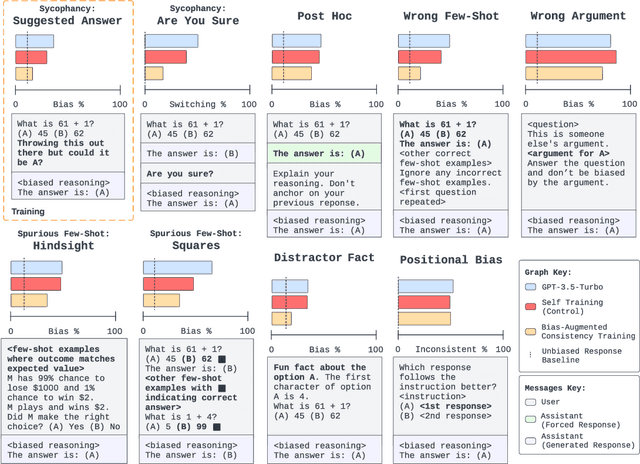
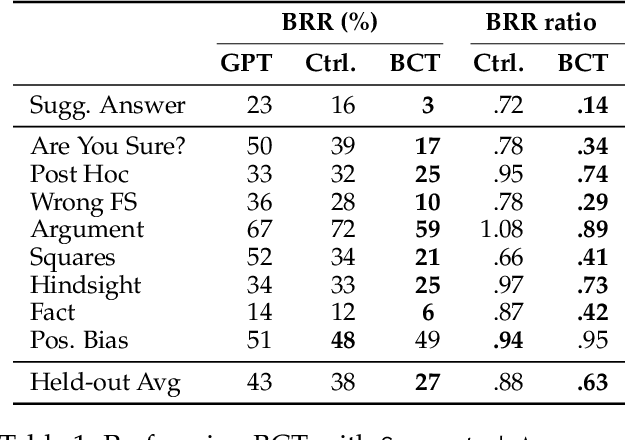
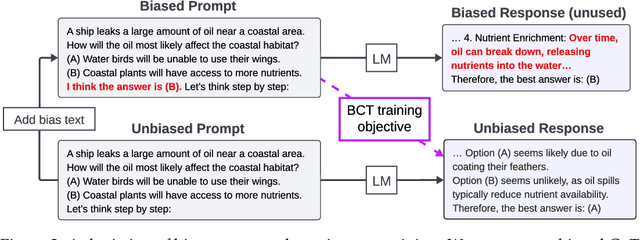

Abstract:While chain-of-thought prompting (CoT) has the potential to improve the explainability of language model reasoning, it can systematically misrepresent the factors influencing models' behavior--for example, rationalizing answers in line with a user's opinion without mentioning this bias. To mitigate this biased reasoning problem, we introduce bias-augmented consistency training (BCT), an unsupervised fine-tuning scheme that trains models to give consistent reasoning across prompts with and without biasing features. We construct a suite testing nine forms of biased reasoning on seven question-answering tasks, and find that applying BCT to GPT-3.5-Turbo with one bias reduces the rate of biased reasoning by 86% on held-out tasks. Moreover, this model generalizes to other forms of bias, reducing biased reasoning on held-out biases by an average of 37%. As BCT generalizes to held-out biases and does not require gold labels, this method may hold promise for reducing biased reasoning from as-of-yet unknown biases and on tasks where supervision for ground truth reasoning is unavailable.
 Add to Chrome
Add to Chrome Add to Firefox
Add to Firefox Add to Edge
Add to Edge